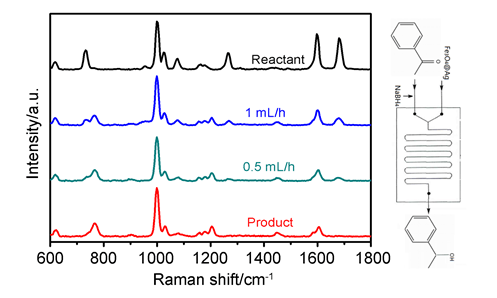| [1] Zhao, Y.; Zhang, Y. L.; Huang, J. A.; Zhang, Z.; Chen, X.; Zhang, W. J. Mater. Chem. A 2015, 3, 6408.
[2] Parisi, J.; Dong, Q.; Lei, Y. RSC Adv. 2015, 5, 14081.
[3] Yaghobian, F.; Weimann, T.; Guttler, B.; Stosch, R. Lab. Chip. 2011, 11, 2955.
[4] Miller, P. W.; Long, N. J.; de Mello, A. J.; Vilar, R.; Passchierc, J.; Gee, A. Chem. Commun. 2006, 5, 546.
[5] Singh, R.; Lee, H. J.; Singh, A. K.; Kim, D. P. Korean J. Chem. Eng. 2016, 33, 2253.
[6] Zhou, J. J.; Tang, Z. K.; Zhang, C.; Wang, D. T.; Zhang, K.; Sun, H. B. Chin. J. Org. Chem. 2016, 36, 2662. (周俊杰, 唐志珂, 张超, 王洞天, 张开, 孙宏滨, 有机化学, 2016, 36, 2662.)
[7] Gao, Y. P.; Wang, J. B. Chin. J. Org. Chem. 2018, 38, 1275. (郜云鹏, 王剑波, 有机化学, 2018, 38, 1275.)
[8] Norbert, K.; Philipp, T.; Christoph, F. T.; Gabriele, L.; Timothy, N. React. Chem. Eng. 2017, 2, 258.
[9] Elvira, K. S.; Casadevall, i.; Solvas, X.; Wootton, R. C. R.; de Mello, A. J. Nature Chem. 2013, 5, 905.
[10] Huang, W. G.; Sun, H. F.; Zhang, S. J. Acta Chim. Sinica 2016, 74, 518. (黄文光, 孙洪飞, 张淑娟, 化学学报, 2016, 74, 518.)
[11] Wang, H. S.; Lin, P. T.; Zhao, S. L.; Li, S. T.; Lu, X.; Liang, H. Chin. J. Chem. 2017, 35, 943.
[12] Zhang, X. N.; Stefanick, S.; Villani, F. J. Org. Process Res. Dev. 2004, 8, 455.
[13] Jin, J.; Cai, M. M.; Li, J. X. Synlett 2009, 15, 2534.
[14] Kong, L. J.; Lin, Q.; Lv, X. M.; Yang, Y. T.; Jia, Y.; Zhou, Y. M. Green Chem. 2009, 11, 1108.
[15] Cao, Y. C.; Jin, R. C.; Mirkin, C. A. Science 2002, 297, 1536.
[16] Long, H. X.; Zhen, Z.; Tang, L. J.; Jiang, J. H. Acta Chim. Sinica 2013, 71, 739. (龙昊旭, 甄珍, 唐丽娟, 蒋健晖, 化学学报, 2013, 71, 739.)
[17] Li, C. Y.; Lai, K. Q.; Zhang, Y. Y.; Pei, L.; Huang, Y. Q. Acta Chim. Sinica 2013, 71, 221. (李春颖, 赖克强, 张源园, 裴鹭, 黄轶群, 化学学报, 2013, 71, 221.)
[18] Li, X. H.; Chen, G. Y.; Yang, L. B.; Jin, Z.; Liu, J. H. Adv. Funct. Mater. 2010, 20, 2815.
[19] Liu, W. J.; Zhu, Z. N.; Deng, K.; Li, Z.; T.; Zhou, Y. L.; Qiu, H. B.; Gao, Y.; Che, S.; Tang, Z. T. J. Am. Chem. Soc. 2013, 135, 9659.
[20] Gao, Z. G.; Zheng, T. T.; Deng, J.; Li, X. R.; Qu, Y. Y.; Lu, Y.; Liu, T. J.; Luo, Y.; Zhao, W. J.; Lin, B. C. Acta Chim. Sinica 2017, 75, 355. (高志刚, 郑婷婷, 邓九, 李晓瑞, 曲玥阳, 陆瑶, 刘婷娇, 罗勇, 赵伟杰, 林炳承, 化学学报, 2017, 75, 355.)
[21] Wang, Y.; Rauf, S.; Grewal, Y. S.; Spadafora, L. J.; Shiddiky, M. J.; Cangelosi, G. A.; Schlucker, S.; Trau, M. Anal. Chem. 2014, 86, 9930.
[22] Huh, Y. S.; Lowe, A. J.; Strickland, A. D.; Batt, C. A.; Erickson, D. J. Am. Chem. Soc. 2009, 131, 2208.
[23] Wang, C.; Yu, C. Nanotechnology 2015, 26, 092001.
[24] Wang, W.; Xu, M. M.; Guo, Q. H.; Yuan, Y. X.; Shen, L. M.; Gu, R. A.; Yao, J. L. RSC Adv. 2015, 5, 47640.
[25] Mao, H.; Wu, W.; She, D.; Sun, G.; Lv, P.; Xu, J. Small 2014, 10, 127.
[26] Xu, B. B.; Zhang, R.; Liu, X. Q.; Wang, H.; Zhang, Y. L.; Jiang, H. B.; Wang, L.; Ma, Z. C.; Ku, J. F.; Xiao, F. S.; Sun, H. B. Chem. Commun. 2012, 48, 1680.
[27] Sun, H. L.; Xu, M. M.; Guo, Q. H.; Yuan, Y. X.; Shen, L. M.; Gu, R. A.; Yao, J. L. Spectrochim. Acta A 2013, 114, 579. |
